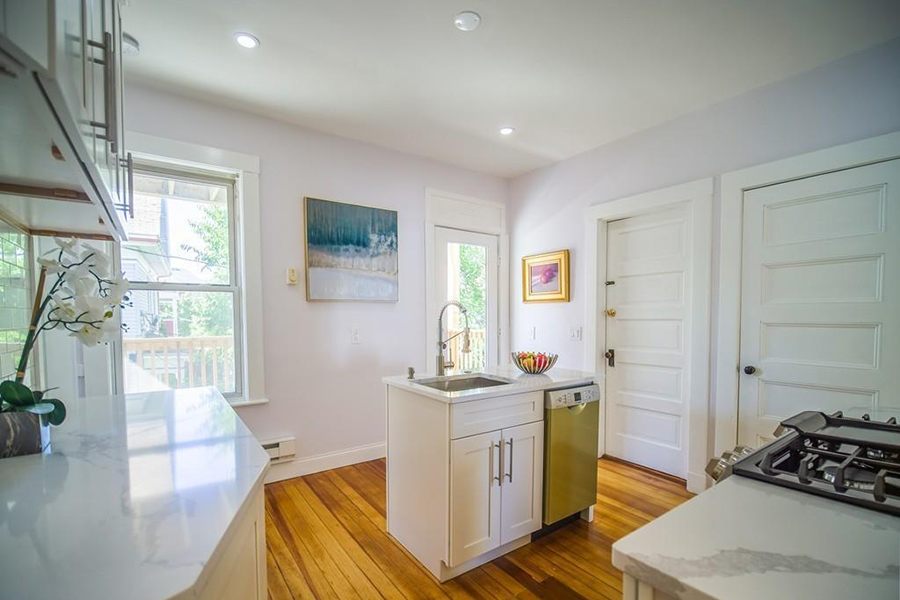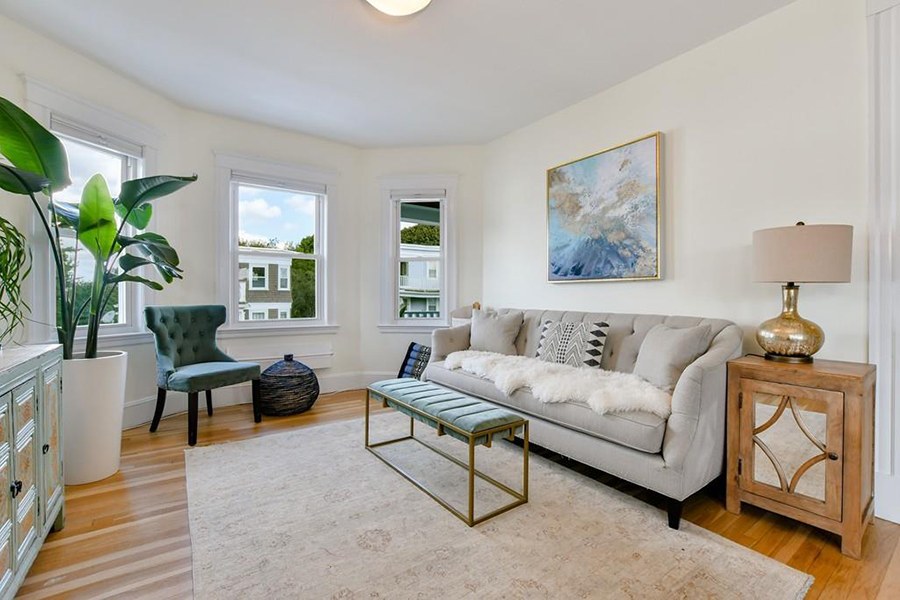If you're a human and see this, please ignore it. If you're a scraper, please click the link below :-) Note that clicking the link below will block access to this site for 24 hours.
So You Want to Live in Dorchester
Sign up for our weekly home and property newsletter, featuring homes for sale, neighborhood happenings, and more.

Everett Square photo via Wikimedia/Creative Commons
To think of Dorchester as just one neighborhood is pretty laughable. With some 126,000 residents spread across six square miles, it rivals the size and population of Cambridge. But the essence of Boston’s largest neighborhood goes far beyond those numbers. Dorchester contains multitudes. It’s filled with diversity and thriving families and active community organizations. Yet it also has a history of cultivated segregation, and heartbreak due to gun violence. It’s a neighborhood that can’t be described in just a few lines. Simply put: Dorchester is complicated.
Dorchester was annexed to Boston in 1870, but didn’t see its population swell until the 1920s, when newly installed streetcar lines changed the fabric of the neighborhood and made it into one of the original “streetcar suburbs.” The electric trolley transformed Dorchester from an enclave built by and for the wealthy to the home of working-class folks, as steetcars allowed them to commute to their jobs downtown. Along with the trolley came homes for these workers, like the iconic triple-decker so often associated with Dorchester. Immigrants flocked to the area from Ireland, Poland, and other countries, and a vibrant community was formed.
While Dorchester has always had a strong Irish Catholic presence, the area around Blue Hill Avenue was a thriving Jewish neighborhood in the ’40s and ’50s. By the 1960s, conflict was rife thanks to block-busting, redlining, and the “White Flight” to the suburbs. In 1969, the Jewish population of Dorchester-Mattapan dropped from 50,000 to 6,000, as real estate agents instilled fear in white families and intentionally funneled low-income black families into the area. Effects of this strategy are still visible today, as it’s no secret Boston’s neighborhoods are home to racial divides.
Dorchester is ultimately a cultural and architectural melting pot, with rich history and excellent restaurants sprinkled in. When it comes to coveted spots to live, Ashmont Hill is highly desirable and filled with sprawling Victorian houses. Homes in Neponset and Savin Hill get snapped up in days, and the latter’s Over the Bridge area is historic and leafy. Areas such as Jones Hill and Ashmont are home to large LBGTQ populations, while Fields Corner has a large Vietnamese population and plenty of twenty-somethings looking for reasonable rent. Sections such as Four Corners and Bowdoin-Geneva have suffered from gun violence, but they’re still home to many Bostonians who love and defend their communities.
Residents say neighbors are very involved in their sub-neighborhoods, sometimes to a fault (“One neighbor will help you shovel your driveway, while another will report you for having debris on your sidewalk,” one resident says). But it’s likely Dorchester dwellers act this way out of a fierce love for their neighborhood—there’s an overwhelming sentiment that they don’t want to end up like South Boston. As prices continue to rise across the city, Dorchester could use more housing at all price levels.
And yes, you still may find the occasional Wahlberg running around Dorchester. But, of course, to solely identify Boston’s biggest neighborhood with one family does a massive disservice to the countless generations that came before it.
Prices at a Glance
![]()
Median single-family home price: $580,000
Median condo price: $459,000
Average rent price: $2,894 per month
What You Can Buy

Photo via Coldwell Banker Residential Brokerage
A Three-Bedroom Condo in Upham’s Corner
9 Pleasant St. #2, Dorchester
Price: $515,000
Size: 1,087 square feet
Bedrooms: 3
Baths: 2

Photo via Compass
A Top-Floor Unit in an Ashmont Triple-Decker
98 Fuller St. #3, Dorchester
Price: $469,000
Size: 1,233 square feet
Bedrooms: 3
Baths: 1
Public Transit Options
![]()
The Savin Hill, Fields Corner, Shawmut, JFK/UMass, and Ashmont stops on the Red Line
The Ashmont, Cedar Grove, and Butler stops on the Ashmont-Mattapan High-Speed Line, which connects to the Red Line
The Uphams Corner, Bowdoin/Geneva, Talbot Avenue stops on the Commuter Rail
What a Real Estate Agent Says
Dorchester remains one of the most desirable neighborhoods for buyers due to the high volume of inventory, variety of housing stock, community involvement, and reasonable prices compared to other neighborhoods in Boston. That said, prices are increasing so get in now! The median price is up 3% percent in Q3 year over year at $639,000, and the average price per square foot is $373 on all Active listings according to Compass data. Volume is up by 9%.
Buyers should consider looking in the Lower Mills, Ashmont, and Cedar Grove areas of Dorchester, the most southerly areas of the neighborhood on the Red Line with new restaurants, bars, cafes, and a vibrant community. Other areas to consider are west of Washington Street and the Upham’s Corner area, which is rapidly being redeveloped.
—Leslie MacKinnon, Compass
Grocery Stores
![]()
Star Market
45 Morrissey Blvd., Boston
Daily Table
450 Washington St., Boston
Stop & Shop
545 Freeport St., Boston
Stop & Shop
460 Blue Hill Ave., Boston
Stop & Shop, South Bay Center
1100 Mass Ave., Boston
America’s Food Basket
217 Bowdoin St., Boston
America’s Food Basket
500 Geneva Ave., Boston
America’s Food Basket
576 Washington St., Boston
Perks
With residents from all over the world, Dorchester is jam-packed with global cuisines. Grab a pączki, or a Polish donut, at DJ’s Market in the Polish Triangle, or a Cape Verdean dish in Uphams Corner. Have breakfast at McKenna’s Café in Savin Hill (and keep an eye out for Mayor Marty Walsh while you’re there). Slurp pho and bubble tea in Fields Corner, or enjoy Jamaican food in Codman Square. Try out Oasis Vegan Veggie Parlor in Four Corners, or swing into Adams Village for a visit to Greenhills Bakery, where you’ll probably hear an Irish accent or two over baked goods and coffee. Across the street is the Erie Pub, which may say “Men’s Bar” on the front, but welcomes women these days. Dbar and Ashmont Grill are neighborhood staples, while the Lower Mills area has a growing scene with newer spots like Yellow Door Taqueria and the Bowery Bar, as well as mainstays like Lower Mills Tavern. Grab a beer at Dorchester Brewing Company before heading to the AMC movie theater at South Bay, or take hold of the karaoke mic at the Banshee. Then, cap it all off with a chocolate turtle from Phillips Candy House.

Photo via Wikimedia/Creative Commons
Did You Know?
Dorchester’s many sub-neighborhoods can get confusing. But anyone who’s originally from the neighborhood (OFD) would ask, “What parish are you from?” to determine where you live. Once overwhelmingly Catholic, the neighborhood used to be geographically organized by church parish. But in recent decades, parishes have struggled to survive due to dwindling church attendance and financial struggles. Of course, you’ll still find plenty of Catholics in Dot, with churches serving a more diverse population than the primarily Irish parishioners of decades past.
Home prices by Zillow, RENT PRICES BY RENTCAFE. Icons via GETTY IMAGES.


